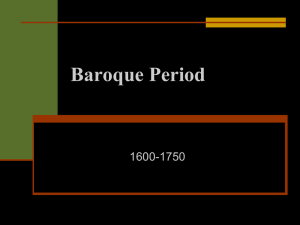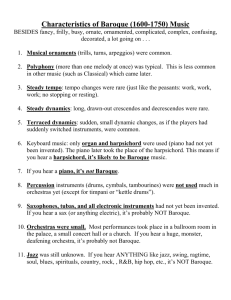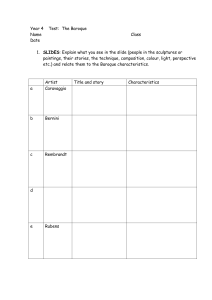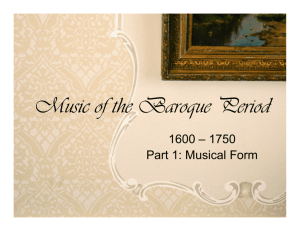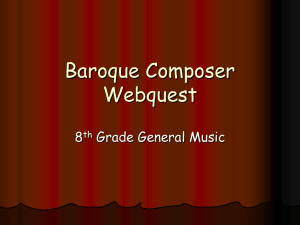Baroque Test - Julianne Baird
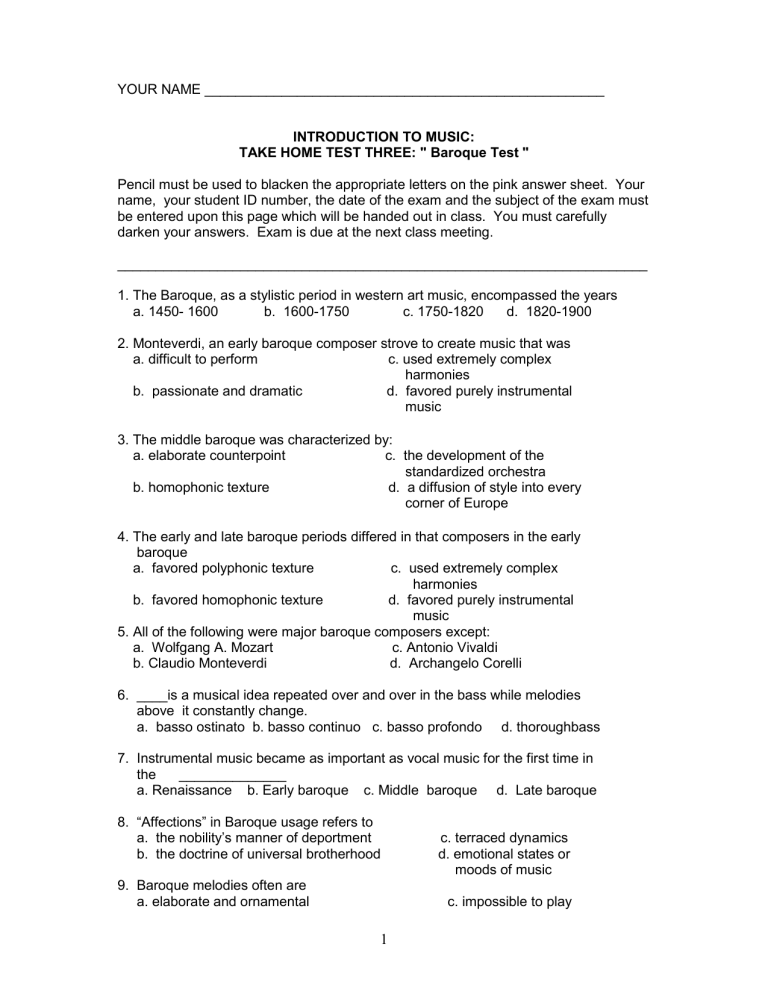
YOUR NAME ____________________________________________________
INTRODUCTION TO MUSIC:
TAKE HOME TEST THREE: " Baroque Test "
Pencil must be used to blacken the appropriate letters on the pink answer sheet. Your name, your student ID number, the date of the exam and the subject of the exam must be entered upon this page which will be handed out in class. You must carefully darken your answers. Exam is due at the next class meeting.
_____________________________________________________________________
1. The Baroque, as a stylistic period in western art music, encompassed the years
a. 1450- 1600 b. 1600-1750 c. 1750-1820 d. 1820-1900
2. Monteverdi, an early baroque composer strove to create music that was
a. difficult to perform c. used extremely complex
harmonies
b. passionate and dramatic d. favored purely instrumental
music
3. The middle baroque was characterized by:
a. elaborate counterpoint c. the development of the
standardized orchestra
b. homophonic texture d. a diffusion of style into every
corner of Europe
4. The early and late baroque periods differed in that composers in the early
baroque
a. favored polyphonic texture c. used extremely complex
harmonies
b. favored homophonic texture d. favored purely instrumental
music
5. All of the following were major baroque composers except:
a. Wolfgang A. Mozart c. Antonio Vivaldi
b. Claudio Monteverdi d. Archangelo Corelli
6. ____is a musical idea repeated over and over in the bass while melodies
above it constantly change.
a. basso ostinato b. basso continuo c. basso profondo d. thoroughbass
7. Instrumental music became as important as vocal music for the first time in
the ______________
a. Renaissance b. Early baroque c. Middle baroque d. Late baroque
8. “Affections” in Baroque usage refers to a. the nobility’s manner of deportment c. terraced dynamics
b. the doctrine of universal brotherhood d. emotional states or
moods of music
9. Baroque melodies often are
a. elaborate and ornamental c. impossible to play
1
b. easy to sing and remember d. short and simple
10. The compelling drive and energy in baroque music are usually provided by
a. frequent ornaments c. repeated rhythmic
patterns
b. complex harmonic progressions d. the high dynamic level
11. Which of the following statements is not true? a. Monteverdi’s Orfeo, composed in 1607 is an early operatic masterpiece b. All twelve of Monteverdi’s operas are popular and regularly performed
c. Monteverdi creates variety in Orfeo by using many styles of music,
combining recitatives, arias, duets, choruses and instrumental interludes
into one dramatic whole d. Monteverdi’s works form a musical bridge between the 16 th and 17 th
centuries and greatly influenced composers of the time
12. Opera in the high baroque consists of two major vocal forms, the aria and
a. recitative b. rondo c. concerto d. fugue
13. The sonata in the baroque period was a composition in several movements
for
a. a solo instrument c. two to four instruments
b. three solo instruments d. one to eight instruments
14. 17 th century England saw only a few compositions by its native sons, of
which
Purcell’s only opera ________ is the best known example
a. Dido and Aeneas b. Venus and Adonis
c. Apollo and Hyacinth d. La Serva Padrona
15. Although born in Germany, Handel shares his musical legacy with _____
his adopted country
a. England b. France c. Belgium d. Ireland
16. Vivaldi spent most of his life working in an institution for orphaned and
illegitimate girls in
a. Rome b. Venice c. Florence d. Cremona
17. A Vivaldi concerto usually has ___ movements
a. a variable number of b. two c. three d. four
18. Of Bach’s twenty children _____(how many) went on to become well-
known composers.
a. two b. three c. four d. five
19. The longest period of J.S. Bach’s professional life was spent as director of
music at St. Thomas Church in:
a. Rome b. Leipzig c. Cothen d. Eisenach
20. Bach achieves unity of mood in his compositions by using
a. homophonic texture c. musical symbolism
b. insistent rhythmic drive d. simple melodic ideas
2
21. Bach was recognized as the most eminent ______of his day
a. organist b. composer c. violinist d. cellist
22. Which of the following statements is not true? a. Bach’s church music uses operatic forms such as the aria and recitative b. the bulk of Bach’s output is instrumental music
c. Bach created masterpieces in every baroque form except opera
d. B ach’s music is unique for its combination of rich harmony and
polyrhythmic texture.
23. Sets of dance-inspired instrumental movements are called
a. sonatas b. concertos c. suites d. cantatas
24. Vivaldi wrote concertos
a. only for string instruments
b. only for violins with continuo
c. for a great variety of instruments
d. only for keyboard instruments
25. Vivaldi was famous and influential as a virtuoso
a. harpsichordist b. tenor c. lutenist d. violinist
26. Vivaldi wrote approximately ___concerti grossi and solo concerti
a. 10 b. 230 c. 59 d. 450
27. A theorbo is a(n)
a. bass woodwind instrument similar to the bassoon
b. electronic instrument whose tone is generated by oscillators
c. plucked and fretted string instrument capable of producing chords as well
as a bass line
d. keyboard instrument suitable for playing basso continuo parts
28. Bach’s personal musical style was drawn from
a. Italian concertos c. German church music
b. French dance pieces d. all of the above
29. A collection of compositions that displays all the resources of fugue writing
is
Bach’s
a. Art of the Fugue
b. Well-Tempered Clavier
c. St. Matthew Passion
d. Wachet Auf-Cantata 140
30. Which of the following statements is not true? a. So many members of the Bach family were musicians that “Bach” became synonymous with “musician”
b. Even though Bach was a deeply religious and pious Lutheran, he
composed what is probably the most monumental setting of the Mass
c. Bach was recognized as the most eminent composer of his day
3
d. Bach spent the last 27 years of his life in Leipzig at a very important
church job
31. In Bach’s day the Lutheran church service lasted about ___ hours.
a. one b. two c. three d. four
32. The ____is a Lutheran congregational hymn tune
a. chorale b. song c. chorale prelude d. recitative
33. Congregational singing of chorales was an important way for people to
a. stay awake in church
b. participate directly in the service
c. learn new music
d. all of the above
34. The various dances in the baroque suite are usually
a. polyphonic texture
b. in theme and variation form
c. in AABB form
d. in ABA form
35. Which of the following is not part of the Baroque suite?
a. allemande b. waltz c. sarabande d. gigue
36. While in Leipzig, Bach
a. taught organ and composition, gave recitals and was often asked to
judge the construction of organs
b. was responsible for the music education of 55 students at St. Thomas
School
c. rehearsed, conducted and usually composed an extended work for
chorus, soloists and orchestra for each Sunday and holiday of the
church year.
d. All of the above
37. A large scale composition for chorus, vocal soloists and orchestra usually set to
a narrative biblical text is called:
a. chorale b. aria c. recitative d. oratorio
38 Bach’s Cantata #140 Wachet Auf is based on the parable of the
a. Good Samaritan
b. wise and foolish virgins
c. lost sheep
d. loaves and the fishes
39. Which of the following is not true?
a. Oratorios first appeared in England
b. Oratorio differs from opera in that it has no acting, scenery, or costumes
c. An oratorio is a large-scale composition for chorus, soloists and
orchestra
4
d. The first oratorios were based on stories from the Bible and were
performed in Lent
40. Which of the following statements is not true?
a. The focus of the Handelian oratorio is usually the chorus b. Most of Handel’s oratorios are without plot or characters since they were primarily intended for church use’
c. Messiah, is set to a text compiled by Charles Jennens from the Old and
New Testament d. Handel’s oratorios are usually based on the Old Testament
41. Handel spent important early training years after first leaving home in:
a. Germany b. Italy c. England d. France
42. G.F. Handel was born in 1685 the same year as
a. J.S. Bach c. Antonio Vivaldi
b. Claudio Monteverdi d. Henry Purcell
43. The Castrato singers of 18 th century
a. Were the highest paid singers of Europe
b. Performed all throughout Europe in the most prestigious Opera theaters
c. Maintained their boyish high voices, grew no chest hair and had a very
large lung capacity
d. All of the above
44. Which of the following oratorios is not by Handel?
a. Messiah b. Elijah c. Israel in Egypt d. Joshua
45. In addition to being a composer and an opera impresario, Handel was a
virtuoso
a. violinist b. organist c. cellist d. trumpeter
46. Although Handel wrote a great deal of instrumental music, the core of his
huge output consists of English oratorios and Italian
a. operas b. songs c. chorales d. madrigals
47. The main keyboard instruments of the Baroque era were organ and the
a. clavichord b. harpsichord c. celeste d. fortepiano
48. Which of the following statements is not true?
a. a large court during the baroque might employ more than 80 performers
including the finest opera singers of the day.
b. Audiences in the baroque period were most anxious to hear old familiar
favorites, and did not care for new music
c. In Italy, music schools were often connected with orphanages
d. Church musicians in the baroque era earned lower pay and had less
status than court musicians
49. The orchestra evolved during the Baroque period into a performing group
based on instruments of the ____family.
a. violin b. woodwind c. brass d. percussion
5
50. The music director (kapellmeister) of the Baroque court was usually not responsible for
a. supervising and directing the musical performance
b. composing much of the music required
c. the discipline of the other musicians
d. publicity in reaching and attracting an audience
51. Bach created masterpieces in every baroque form except the
a. Opera
b. Concerto
c. Fugue
d. Sonata
52. The first oratorios were based on
A. Greek mythology
B. Contemporary literature
C. Shakespeare
D. Old testament stories from the Bible
53. Which of the following is not true
A. Music influenced by dance tends to have balanced phrases
B. Music influenced by the dance tends to have asymmetrical phrases
C. Formal dancing has a set of steps in one direction balanced by similar motion in the opposite direction.
D. Many pieces other than “suites” contain dance movements
54. Embellishments are
A. Ornamental tones not printed in the music that seventeenth- and eighteenthcentury performers were expected to add to the melody
B. Music created at the same time that it is performed
C. Notes printed in the music that embellish the melody
D. Obsolete in contemporary performances
55. A ________ is a singer with a low range who usually takes comic roles
A. tenor B. basso buffo C. basso profondo D. Buffoon
56. A song for solo voice with orchestral accompaniment is called
A. Aria B. duet C. ensemble D. solo
57. The word movement in music normally refers
A. music for the ballet
B. A piece that sounds fairly complete and independent but is part of a
larger composition
C. The rising and falling of the melodic contour
D. The rhythm of a piece
58. __________is an operatic number involving three or more lead singers
A. Aria B. Ensemble C. Duet D. Chorus
6
59. Which of the following statements is not true?
A. A large court during the baroque might employ more than eighty
performers, including the finest opera singers of the day.
B. Audiences in the baroque period were most anxious to hear old familiar
favorites and did not care for new music
C. In Italy, music schools were often connected with orphanages.
D. Church musicians in the baroque period earned lower pay and had less
status than court musicians.
60. The most characteristic feature of baroque music is its use of
A. gradual dynamic changes
B. monophonic texture
C. basso continuo
D. simple singable melodies
61. The baroque principle of ____ may be temporarily suspended in vocal
music when drastic changes of emotion in a text inspires corresponding
changes in the music.
A. basso continuo B. unity of Mood
C. Terraced dynamics D. All of the above
62. The main theme of the fugue is called the
A. Answer B. Subject C. Counter subject D. Episode
63. Which of the following statements is not true
A. Lutheran chorales were tunes that had been composed in the sixteenth
and seventeenth centuries or had been adapted from folk songs and
Catholic hymns.
B. In a sense, the cantata was a sermon in music that reinforced the minister’s sermon.
C. When chorale melodies were harmonized for church choirs, the tune
was assigned to the tenors
D. The cantata of Bach’s day might last 25 minutes and contain several
different movements, including choruses, recitatives, arias, and duets.
64. Although all the movements of a Baroque suite are written in the same key,
they differ in
A. meter B. national origin C. tempo D. all of the ABove
65. Which of the following statements is not true?
A. Baroque suites often begin with a French Overture
B. Dance movements exist exclusively in works entitled “suites”.
C. A baroque suite is made up of different movements that are all written in
the same key but differ in tempo, meter, and character
D. The various dances of the baroque suite are usually in AABB form.
66. In their use of aria, duet, and recitative, Bach’s cantatas closely resembled
the ______ of the time.
A. suites B. operas C. concertos D. sonatas
67. George Frideric Handel’s Messiah is an example of
7
A. an oratorio B. an opera C. mummery d. an aria
68. Oratorios first appeared in
A. Germany B. England C. Italy D. France
69. Handel spent the major portion of his life in
A. Germany B. England C. Italy D. France
70. The Lutheran chorale tunes
A. had been adapted from Catholic hymns
B. were composed in the 16 th and 17 th centuries
C. Had been adapted from folk songs
D. All of the above
71. The abbreviation op. stands for opus, Latin for
A. Spring B. eyes C. work D. opportunity
72. Some o f Vivaldi’s instrumental concertos were arrangd by
A. Archangelo Corelli C. George Frideric Handel
B. Johann Sebastian Bach D. Claudio Monteverdi
73. Antonio Vivaldi is closely identified with the musical life of
A. Rome B. Venice C. Cremona D. Florence
74. Corelli’s Trio Sonata in A minor, Op. 3, no 10 is scored for
A. two violins C. two violins and Basso continuo
B. solo violin and orchestra D. piano, violin and cello
75. Characteristic of baroque trio sonatas the second movement of Corelli’s Trio
Sonata in A Minor, Op. 3, n o 10 is
A. slow and dignified B. songlike C. fuguelike D. a dance
76. Which is not a characteristic of a chorale prelude
A. based on a hymn tune
B. short composition for organ
C .used to remind the congregation of the melody of the chorale
D. used to signal when the hour long sermon was over
77. A musical ornament consisting of the rapid alternation of two tones that are a
whole or half step apart is a
A. trill B. mordent C. appoggiatura D scheifer
78. Baroque suites frequently begin with a
A. French overture B. gavotte C. gigue D. Sarabande
79. Baroque trio sonatas usually involve ___________ performers
A. two B. three C four D. five
80. Henry Purcell’s opera
Dido and Aeneas was inspired by the Aeneid, an epic
poem by
A. Homer B. Virgil C Naham Tate D. Sophocles
8
81.Which of the following statements is not true?
A. Henry Purcell was virtually unknown in his own time, but today is considered
the greatest of English composers
B. Purcell mastered all the musical forms of late seventeenth century England,
including church music, secular choral music, music for small groups of
instruments, songs, and music for the stage.
C. Purcell’s music is filled with lively rhythms and a fresh melodic style that
captures the spirit of English folk songs
D. Dido, in Virgil’s epic poem that Purcell used as the basis for his opera Dido
and Aeneas, was queen of Carthage
82. The _____ is the person who beats time, indicates expression, cues in
musicians and controls the balance among instruments and voices.
A. prima donna B. prompter C. concertmaster D. conductor
83. Speechlike melody accompanied only by a basso continuo is called
A. Basso ostinato C. Secco recitative
B. Accompanied recitative D. Aria
84. The two major forms of Baroque opera are
A. Discant and Counterpoint C. Recitative and Aria
B. Secco and Accompagnato D. dissonance and consonance
85. A typical baroque operatic form was the da capo aria in ABA form in which the
singer
A. Would make a literal and exact repetition of the opening A section after the B
section
B. Was expected to embellish the returning melody with ornamental tones
C. Would insert recitatives between the sections for added variety
D. Would improvised new words for the returning A section
86. Members of the Florentine Camerata wanted to create a new vocal style based
on the
A. music of the ancient Greek tragedies C. love poetry of the troubadours
B. glories of their aristocratic patrons D. the polyphonic madrigal
87. Which of the following statements is not true?
A. Most early baroque operas were based on Greek mythology and ancient
history.
B. The members of the Florentine Camerata based their theories on actual
dramatic music that had come down to them from the Greeks
C. The members of the Florentine Camerata wanted to create a new vocal style
modeled on the music of ancient Greek tragedy
D. Polyphony was rejected by the members of the Florentine Camerata because
different words sounding simultaneously would obscure the text.
88. The solo instruments in Bach’s Brandenburg Concerto No, 5 are the ______,
violin, and harpsichord.
A. trumpet B. cello C. flute D. oboe
9
89. A polyphonic composition based on one main theme, a cornerstone of baroque
music, is the
A. subject B. concerto C. Episode D.fugue
90. The principal and often recurring theme of a concerto grosso movement is
called the
A. ritornello B sonata C. Basso continuo D ripieno
91. An ____ is a play, set to music, sung to orchestra accompaniment
A. overture B. opera C. aria D. Ensemble
92. a song for solo voice with orchestra accompaniment is called:
A. aria B. Duet C. Ensemble D. solo
93. Which of the following statements is not true?
A. The terms castrato and alto are synonymous
B. Voice categories in opera are divided more finely that in other musical
genres
C. Operas may contain spoken dialogue, but most are entirely sung
D. Opera soloists must create a wide variety of characters, and so need acting
skills as well as vocal artistry.
94. The text, or book, of a musical dramatic work is called the
A. text B. libretto C. story D. score
95. Vivaldi makes clear his programmatic intentions in the “Seasons” by
A. Entitling the movements by the names Fall, Spring, Winter, and Summer
B. adding descriptive labels at certain points in the music
C. Inserting lines from the poems at appropriate passages in the musical score
D. All of the above
96. Which of these is not true? A “supernumerary” in opera
A. sings in the opera
B. is also known as an ”extra”
C. provides the translation of the text
D. may fill out a crowds
97. Which of the following is not true? A coloratura soprano . . .
A. has a low voice
B. can execute rapid scales
C. has a rapid trill
D. has a very high range
97. Which of the following is not true? Recitative . . .
A. Carries the action forward and presents routine information quickly.
B. Usually has only one note per syllable
C. often employs repeated notes
D. often stops the action while the character’s feelings are revealed through
music
98. In the baroque era chromatic ground basses were commonly used to show
A. Grief B. Joy C. Anger D. Dismay
10
99. Which of the following is not true? During the plot of Dido and Aeneas
A. Witches plot Dido’s downfall
B. Aeneas falls in love with Dido the Queen of Carthage
C. Dido kills herself at the end of the opera
D. Dido plots Aeneas’ downfall
100. Which of the following is not true? During the middle phase of the Baroque .
A. a new musical style spread from Italy to practically every European country
B. Major and minor scales replaced the church modes
C. Instrumental music achieved a new importance
D. Instrumental music became as important as vocal music
11



